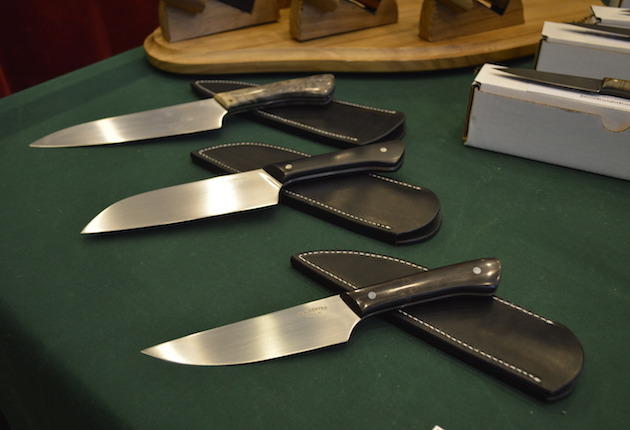The Southeastern Wildlife Exposition is a show centered around hunting art. Not all of that art is made with oils or clay; much of it was housed in the Gaillard Center in Downtown Charleston, S.C., where knifemakers from around the region and world gathered to show their products.
Amid the many custom pieces designed specifically for hunting and fishing were extraordinary knives meant for perfectly ordinary tasks.
“A kitchen knife is something most people use at least five times a week, unless you eat out all the time, which I don’t think is realistic for a lot of people,” said Matt Rochester, a custom knifemaker at this year’s SEWE show. “Even in hunting and fishing, everything you kill you’re going to wind up eating.”
Matt is the man behind Rochester Knives of Seneca, S.C. While hunting knives do make up a significant portion of his business, he reminds customers that the cutting doesn’t stop when the meat leaves the woods.
“Once you get it in the kitchen you’re going to need something to prepare it with,” Rochester said.

Matt Rochester with one of his custom kitchen knives.
Even on a good year, a hunting knife may be used a handful of times in the field. Kitchen knives play an important role in hunting and fishing, but also in the day-to-day cooking of an average family.
“The fastest growing trend in handmade knives is kitchen cutlery,” said Sporting Classics‘ Ron Stepp. “When you think about the possibility of using your hunting knife, it’s three months long and you may get to use it three or four times in a season. But you use a kitchen knife every single day. So everything you shoot in the field or grow in the garden, you have an opportunity to use these knives.”
Stepp further put his stamp of approval on Matt’s work by sharing his SEWE booth with Rochester — a high compliment for the young knifemaker.
Rochester had three kitchen pieces available at SEWE, pictured in the cover image of this article: a five-inch Petty (bottom) for all-around cutting, a six-inch Santoku (middle), and a western-style, seven-inch chef’s knife (top). Each is constructed from stainless steel and features a finely ground edge. The top of the blade is slightly rounded to provide comfort when applying pressure.
The knives are created and completed by Rochester in his shop.
“I try not to send anything out that I don’t have to,” he joked. “I haven’t had to yet.”
Rochester thinks custom kitchen cutlery is perfectly timed for a nation returning to its roots.
“I think this country has went through a period where everyone used to cook at home, then we went through a time when nobody did. Everybody went out to eat, but now they’re kind of coming back to it.”
For more information about Rochester Knifeworks, contact Matt at (864) 506-4247 or email him at Mattr2589@yahoo.com.

